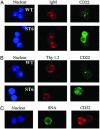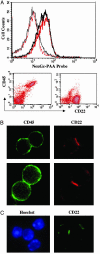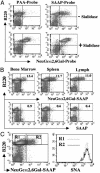Masking of CD22 by cis ligands does not prevent redistribution of CD22 to sites of cell contact
- PMID: 15079087
- PMCID: PMC395930
- DOI: 10.1073/pnas.0400851101
Masking of CD22 by cis ligands does not prevent redistribution of CD22 to sites of cell contact
Abstract
CD22, a negative regulator of B cell signaling, is a member of the siglec family that binds to alpha2-6-linked sialic acids on glycoproteins. Previous reports demonstrated that binding of multivalent sialoside probes to CD22 is blocked, or "masked," by endogenous (cis) ligands, unless they are first destroyed by sialidase treatment. These results suggest that cis ligands on B cells make CD22 functionally unavailable for binding to ligands in trans. Through immunofluorescence microscopy, however, we observed that CD22 on resting B cells redistributes to the site of contact with other B or T lymphocytes. Redistribution is mediated by interaction with trans ligands on the opposing cell because it does not occur with ligand-deficient lymphocytes from ST6GalI-null mice. Surprisingly, CD45, proposed as both a cis and trans ligand of CD22, was not required for redistribution to sites of cell contact, given that redistribution of CD22 was independent of CD45 and was observed with lymphocytes from CD45-deficient mice. Furthermore, CD45 is not required for CD22 masking as similar levels of masking were observed in the WT and null mice. Comparison of the widely used sialoside-polyacrylamide probe with a sialoside-streptavidin probe revealed that the latter bound a subset of B cells without sialidase treatment, suggesting that cis ligands differentially impacted the binding of these two probes in trans. The combined results suggest that equilibrium binding to cis ligands does not preclude binding of CD22 to ligands in trans, and allows for its redistribution to sites of contact between lymphocytes.
Figures




Similar articles
-
Constitutively unmasked CD22 on B cells of ST6Gal I knockout mice: novel sialoside probe for murine CD22.Glycobiology. 2002 Sep;12(9):563-71. doi: 10.1093/glycob/cwf067. Glycobiology. 2002. PMID: 12213789
-
Transitional and marginal zone B cells have a high proportion of unmasked CD22: implications for BCR signaling.Int Immunol. 2003 Oct;15(10):1137-47. doi: 10.1093/intimm/dxg114. Int Immunol. 2003. PMID: 13679384
-
Natural ligands of the B cell adhesion molecule CD22 beta can be masked by 9-O-acetylation of sialic acids.J Cell Biol. 1994 Jul;126(2):549-62. doi: 10.1083/jcb.126.2.549. J Cell Biol. 1994. PMID: 8034751 Free PMC article.
-
CD22, a B lymphocyte-specific adhesion molecule that regulates antigen receptor signaling.Annu Rev Immunol. 1997;15:481-504. doi: 10.1146/annurev.immunol.15.1.481. Annu Rev Immunol. 1997. PMID: 9143697 Review.
-
[CD22: a cell adhesion molecule that displays alpha 2-6-linked sialic acid-binding lectin activity].Seikagaku. 1995 Aug;67(8):1040-7. Seikagaku. 1995. PMID: 7594871 Review. Japanese. No abstract available.
Cited by
-
Absence of Neu5Gc and Presence of Anti-Neu5Gc Antibodies in Humans-An Evolutionary Perspective.Front Immunol. 2019 Apr 30;10:789. doi: 10.3389/fimmu.2019.00789. eCollection 2019. Front Immunol. 2019. PMID: 31134048 Free PMC article. Review.
-
Stable masking by H-2Dd cis ligand limits Ly49A relocalization to the site of NK cell/target cell contact.Proc Natl Acad Sci U S A. 2007 Mar 6;104(10):3978-83. doi: 10.1073/pnas.0607418104. Epub 2007 Feb 26. Proc Natl Acad Sci U S A. 2007. PMID: 17360463 Free PMC article.
-
Sugar-decorated carbon dots: a novel tool for targeting immunomodulatory receptors.Nanoscale Adv. 2022 Nov 3;4(24):5355-5364. doi: 10.1039/d2na00364c. eCollection 2022 Dec 6. Nanoscale Adv. 2022. PMID: 36540112 Free PMC article.
-
Siglec-mediated regulation of immune cell function in disease.Nat Rev Immunol. 2014 Oct;14(10):653-66. doi: 10.1038/nri3737. Epub 2014 Sep 19. Nat Rev Immunol. 2014. PMID: 25234143 Free PMC article. Review.
-
Unmasking of CD22 Co-receptor on Germinal Center B-cells Occurs by Alternative Mechanisms in Mouse and Man.J Biol Chem. 2015 Dec 11;290(50):30066-77. doi: 10.1074/jbc.M115.691337. Epub 2015 Oct 27. J Biol Chem. 2015. PMID: 26507663 Free PMC article.
References
-
- Nitschke, L., Carsetti, R., Ocker, B., Kohler, G. & Lamers, M. C. (1997) Curr. Biol. 7, 133-143. - PubMed
-
- Sato, S., Miller, A. S., Inaoki, M., Bock, C. B., Jansen, P. J., Tang, M. L. & Tedder, T. F. (1996) Immunity 5, 551-562. - PubMed
-
- Otipoby, K. L., Andersson, K. B., Draves, K. E., Klaus, S. J., Farr, A. G., Kerner, J. D., Perlmutter, R. M., Law, C. L. & Clark, E. A. (1996) Nature 384, 634-637. - PubMed
-
- Doody, G. M., Justement, L. B., Delibrias, C. C., Matthews, R. J., Lin, J., Thomas, M. L. & Fearon, D. T. (1995) Science 269, 242-244. - PubMed
-
- Cyster, J. G. & Goodnow, C. C. (1997) Immunity 6, 509-517. - PubMed
Publication types
MeSH terms
Substances
Grants and funding
LinkOut - more resources
Full Text Sources
Other Literature Sources
Molecular Biology Databases
Research Materials
Miscellaneous

